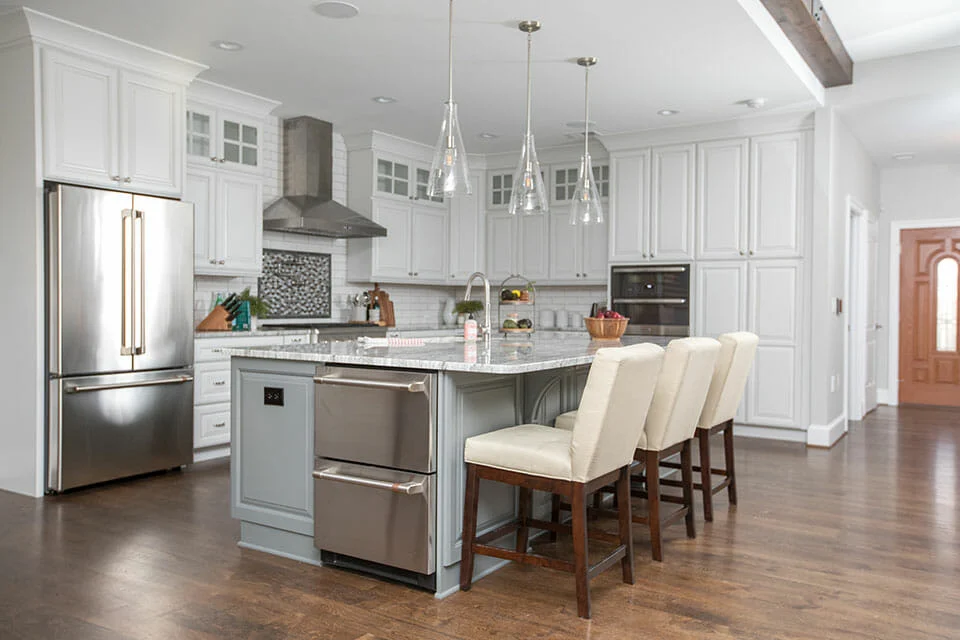Enhance your home with universal design for aging in place, ensuring inclusivity and comfort. Features like wider doorways and lever handles support diverse needs. Optimize your space for aging needs while promoting independence.
Key Takeaways
- Universal Design improves accessibility and inclusivity for all ages and abilities.
- Features like wider doorways and lever handles benefit individuals with diverse needs.
- Enhances independence, comfort, and well-being in home environments.
- Age-inclusive home modifications support aging residents and individuals of varying abilities.
- Creates a welcoming and functional environment promoting peace of mind and independence.
Challenges of Aging in Place
Handling the later years of life presents individuals with a variety of challenges when it comes to aging in place. From mobility limitations to safety concerns, dealing with these obstacles can be overwhelming. Yet, with the right support systems, modifications to the home, and access to necessary resources, aging in place can become a more manageable and fulfilling experience for seniors seeking comfort, independence, and a sense of belonging.
Understanding Universal Design
Understanding Universal Design is e for creating living spaces that cater to individuals of all ages and abilities. By focusing on core principles of universality, such as flexibility and simplicity, homes can be transformed to meet verse needs. Implementing practical application tips e that the design is not only inclusive but functional for everyone who resides in the space.
Core Principles of Universality
Incorporating the core principles of universality is essential for creating spaces that are inclusive and accessible to individuals of all ages and abilities.
- Flexibility in Use
- Simple and Intuitive
- Equitable Use
- Perceptible Information
These principles guarantee that everyone can navigate and utilize spaces comfortably, promoting a sense of belonging and independence for individuals of diverse backgrounds and abilities.
Benefits for All Ages
Embracing the concept of universal design not only improves accessibility but nurtures a sense of inclusivity and independence for individuals of all ages and abilities. By incorporating features like wider doorways, lever handles, and zero-step entries, homes become welcoming and functional for everyone. This design approach c that individuals feel supported and empowered in their living spaces, promoting a sense of belonging and well-being for people of diverse needs and backgrounds.

Practical Application Tips
When implementing universal design principles, it is crucial to consider practical application tips that improve accessibility and functionality in living spaces for individuals of all ages and abilities.
- Leverage Lever Handles: Replace doorknobs with lever handles for easier operation.
- Install Grab Bars: Strategically place grab bars in key areas like bathrooms and staircases.
- Enhance Lighting: Guarantee adequate lighting in all rooms for better visibility.
- Create Open Pathways: Design open floor plans to aid movement without obstacles.
Benefits of Universal Design
Universal Design offers a variety of advantages that cater to the needs of individuals looking to age in place. Improved accessibility features and age-inclusive home modifications are key components of Universal Design that empower independence and comfort. By integrating these elements, homes can be transformed into safe, functional spaces that support aging individuals in maintaining their autonomy.
Enhanced Accessibility Features
Improving the accessibility features in a home through universal design can greatly improve daily living for individuals of all ages and abilities.
- Increased mobility for wheelchairs and walkers.
- Lever-style door handles for effortless opening.
- Grab bars in key areas for additional stability.
- Non-skid flooring to prevent accidents.
Age-Inclusive Home Modifications
Improving the comfort of a home through considerate modifications benefits individuals of all ages, fostering safety and coziness in daily living. Age-inclusive home modifications, such as installing grab bars, lever-style door handles, and slip-resistant flooring, increase accessibility and usability for everyone. These thoughtful adjustments not only support aging residents but create a welcoming and functional environment for individuals of varying abilities, promoting independence and peace of mind.
Implementing Universal Design Principles
When considering the development of living areas that cater to individuals of all ages and abilities, integrating design principles that promote accessibility and functionality is crucial. Here are four key elements to consider when implementing universal design principles:
- Open Floor Plans: Improve mobility and maneuverability.
- Lever Door Handles: Enhance ease of use for all.
- Non-Slip Flooring: Boost safety for everyone.
- Adjustable Countertops: Accommodate varying height needs.
Adapting Homes for Aging Needs
Adapting homes to meet the evolving needs of aging individuals requires thoughtful consideration of both practical functionality and comfort. From installing grab bars in bathrooms to creating step-free entrances, these modifications aim to improve daily living for older adults. Embracing adaptable design elements can nurture a sense of belonging and independence, promoting a home environment that evolves gracefully with its residents’ changing needs.
Safety and Accessibility Considerations
Ensuring a home’s safety and accessibility involves implementing thoughtful design features that improve comfort and independence for aging individuals.
- Grasp Bars: Strategically placed in bathrooms and near stairs.
- Anti-Skid Flooring: Prevents slips and falls.
- Broader Doorways: Allows for easy navigation with mobility aids.
- Handle Door Levers: Easier to operate for those with limited hand strength.
Enhancing Quality of Life
To truly optimize the living experience for aging individuals, it is imperative to focus on enhancing their quality of life through thoughtful design considerations that promote comfort, functionality, and a sense of well-being in their homes. By incorporating features like ergonomic furniture, easy-to-reach storage, and abundant natural light, ageless homes create a nurturing environment that cultivates independence, safety, and emotional well-being for residents.
Cost-Effective Aging Solutions
Incorporating cost-effective aging solutions into home design can significantly improve the accessibility and functionality of living spaces for seniors while considering budget constraints and long-term financial planning.
- Smart Home Technology: Allows for remote monitoring and control.
- Grab Bars and Handrails: Provide stability and support.
- Non-Slip Flooring: Reduces the risk of falls.
- Ramps and Lifts: Boost mobility within the home.
Future-Proofing Homes
Future-proofing homes involves implementing design elements that anticipate and accommodate the changing needs of individuals as they age, ensuring long-term functionality and comfort. By incorporating features like spacious doorways, lever-style door handles, and accessible bathrooms, homes can remain suitable for residents of all ages. This proactive approach to design promotes a sense of security and inclusivity, creating spaces where individuals can thrive regardless of their age.
Frequently Asked Questions
How Can Universal Design Benefit Individuals of All Ages, Not Just Seniors?
Universal design benefits individuals of all ages by creating spaces that are accessible, safe, and functional for everyone. It promotes independence and inclusivity, enhancing quality of life and nurturing a sense of community through thoughtful and user-friendly design.
What Are Some Key Features of Universal Design That Can Enhance the Accessibility of a Home?
Key features of universal design in homes include level entrances, spacious doorways, lever-type door handles, abundant lighting, slip-resistant flooring, support bars in bathrooms, and adaptable countertops. These features improve accessibility, safety, and comfort for individuals of all ages and abilities.
Are There Specific Guidelines or Standards That Should Be Followed When Implementing Universal Design Principles?
When implementing universal design principles, it is vital to adhere to specific guidelines and standards to guarantee ideal accessibility and inclusivity. Following established criteria guarantees that spaces are thoughtfully designed to accommodate diverse needs seamlessly.
How Can Homeowners Go About Adapting Their Current Homes to Better Suit Their Aging Needs?
Homeowners can adapt their current homes for aging needs by installing grab bars, lever-style door handles, and non-slip flooring. Furthermore, creating a single-level living space, widening doorways, and ensuring good lighting can improve safety and accessibility for aging residents.
What Are Some Cost-Effective Solutions for Incorporating Universal Design Into a Home Renovation Project?
Incorporating universal design into a home renovation project can be cost-effective by focusing on simple modifications like lever door handles, grab bars, and non-slip flooring. These adjustments improve accessibility and safety without breaking the budget.
Conclusion
In summary, the implementation of Universal Design for Aging in Place offers a practical and creative solution to address the challenges of aging in residential spaces. By prioritizing accessibility, safety, and overall quality of life for occupants, this design philosophy not only meets the present needs of residents but future-proofs homes for evolving requirements. Embracing Universal Design principles is a cost-effective way to create ageless homes that cater to individuals of all ages and abilities, building better tomorrows for everyone.
You may also like to read:
Effective Home Construction Tips for Closing Deals





